The Meizu PRO 5 Review
by Matt Humrick on June 24, 2016 8:00 AM EST- Posted in
- Smartphones
- Exynos
- Mobile
- Meizu
- Exynos 7420
System Performance
The Meizu PRO 5’s internal hardware is very similar to the Samsung Galaxy S6’s—Exynos 7420 SoC, LPDDR4 1552MHz RAM, UFS 2.0 NAND—so it’s not unreasonable to expect a similar level of performance. When the PRO 5 and Galaxy S6 launched in 2015, the Exynos 7420 was the SoC to beat, offering better performance and efficiency thanks in part to being the first to use Samsung’s FinFET process. The Exynos 7420 has since been eclipsed by a new generation of SoCs, but it still delivers solid performance.
Smartphones are about more than just performance, of course. Battery life is paramount and is ultimately what makes a mobile device mobile. To help its users strike the right balance between these two opposing metrics, Meizu’s Flyme OS offers three different power modes: Saving, Balance, and Performance. The Saving mode shuts down the four higher-performing but higher-power Cortex-A57 CPU cores, effectively giving the PRO 5 a quad-core Cortex-A53 CPU running at up to 1.5GHz, and is meant to prolong battery life at the expense of performance. The Balance mode, like its name suggests, tries to strike an equal balance between battery life and performance by disabling two A57 cores and capping the max frequency of the remaining two at 1.8GHz. The four A53 cores are still available at their max frequency of 1.5GHz. The Performance mode allows all eight CPU cores to run at their max rated frequencies simultaneously if needed.
To measure the impact of this strategy, we tested the PRO 5 in both its Performance and Balance modes. Results for both are shown in the charts on the next few pages.
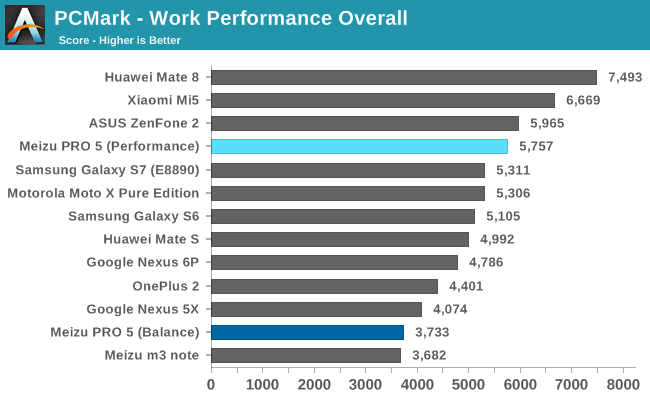
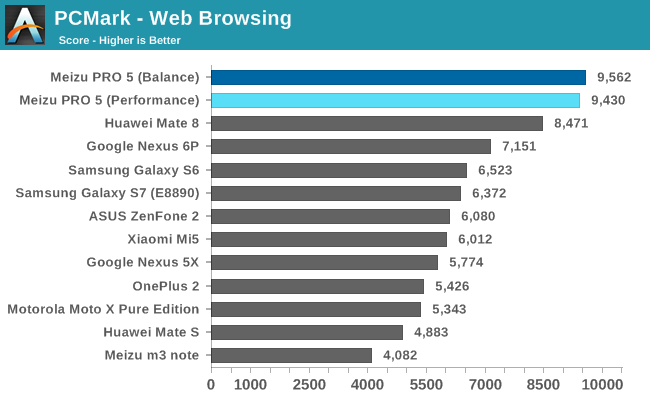
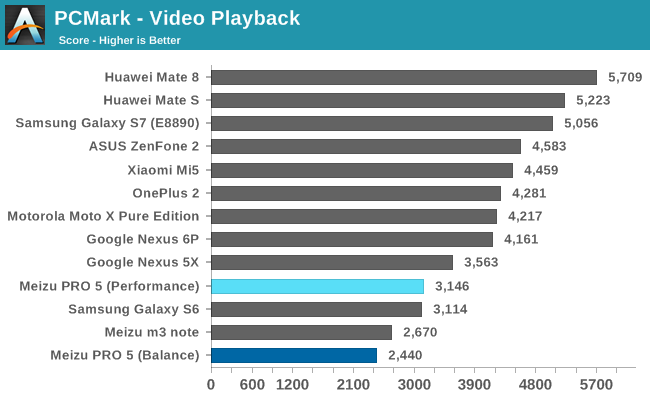
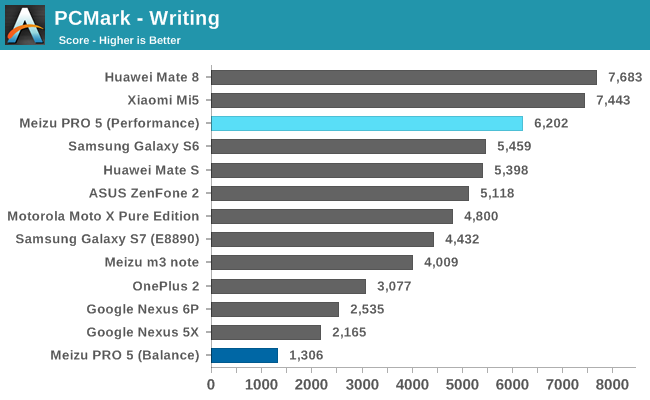
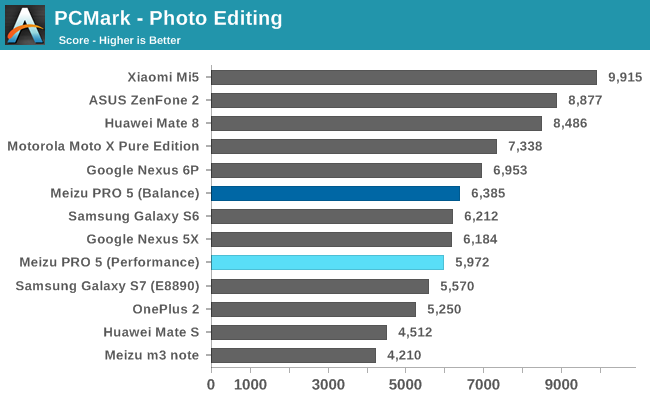
PCMark’s real-world workloads evaluate overall system performance by exercising the CPU, RAM, and NAND storage. Instead of pegging the CPU cores at their max frequency like synthetic benchmarks, PCMark elicits more realistic behavior from the CPU governor, making it a good indicator of how other apps that we use every day will perform.
Looking first at the overall score, the PRO 5 does well, outperforming even newer flagships like the Galaxy S7. We also see a significant difference between the PRO 5’s Performance and Balance modes, with the former providing a 54% boost. However, overall scores can often be misleading.
Diving into the individual tests, the PRO 5 seems to deliver exceptional performance in Web Browsing with no discernable difference between the two power modes. Video Playback is similar to the Galaxy S6 in Performance mode, which holds a 29% advantage over Balance mode, although neither device using the Exynos 7420 does particularly well in this test. The PRO 5, like the S6, performs well in the Writing test, well, at least sometimes.
The PRO 5 produces erratic results in both the Video Playback and Writing tests when using the Performance mode. Around half the time it delivers results similar to those in the charts above. The other times, however, the PRO 5 shuts down the A57 cores completely and idles the A53 cores at 400MHz for the duration of these two tests, resulting in horrible scores. This appears to be a bug with Meizu’s DVFS implementation. The good news is that I was not able to reproduce this scenario while running several different apps from Meizu, Google, and third-parties, so this appears to be limited to PCMark. Without more comprehensive testing there’s no guarantee that some app or workload will not trigger this behavior, however. Using Balance mode could be a workaround, because it did not suffer from this issue.

We recently added DiscoMark to our test suite as part of our effort to better capture real-world performance. You can find a good explanation of how this test works and how we are using it in our LG G5 review, but basically this test measures application launch times by using Android's accessibility services to monitor an application’s startActivity() method, which starts the process of building the app’s UI elements.
The PRO 5 opens apps from internal storage very quickly, noticeably faster than the Nexus 5X and Nexus 6P, and essentially equal to even the latest flagship phones. Switching to Balance mode slows performance by 31%, but it still feels very fast.
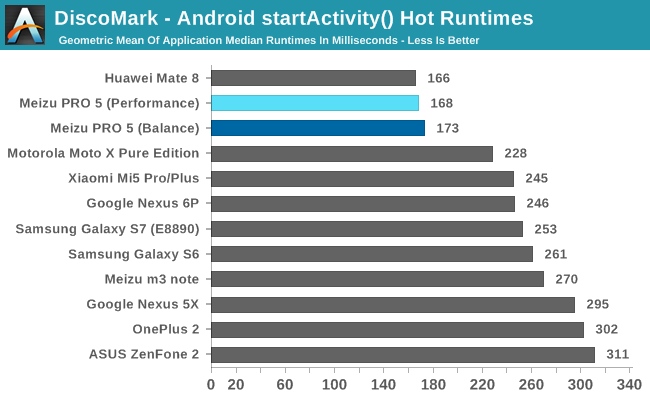
The PRO 5 is also very fast when switching between apps that are already loaded in RAM, with no penalty when using Balance mode. It equals the performance of Huawei’s Mate 8 and P9 and holds a 25% to 35% advantage over the other phones in the chart going back to the Galaxy S6.
Taken together, PCMark and DiscoMark show the PRO 5 performs very well with common, everyday tasks, which agrees with my personal experience while using the phone. The UI is fluid, the keyboard responds as quickly as I can move my thumbs, and scrolling through image-heavy web pages is smooth.

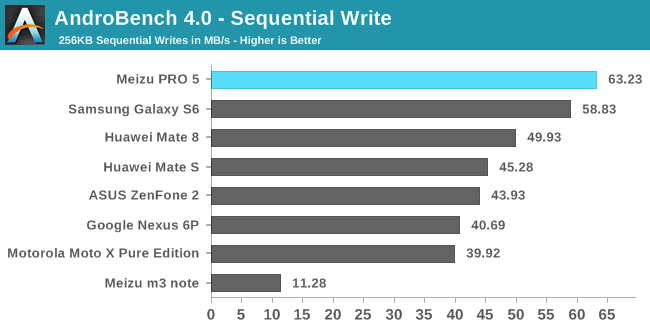
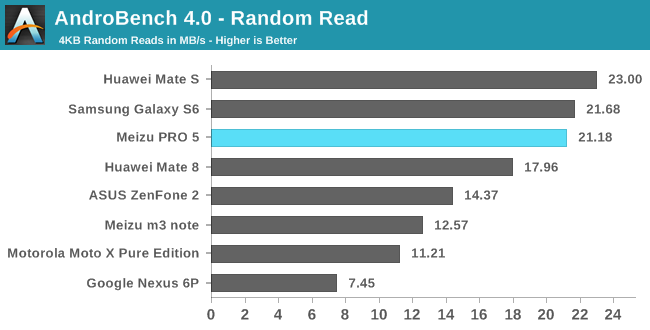
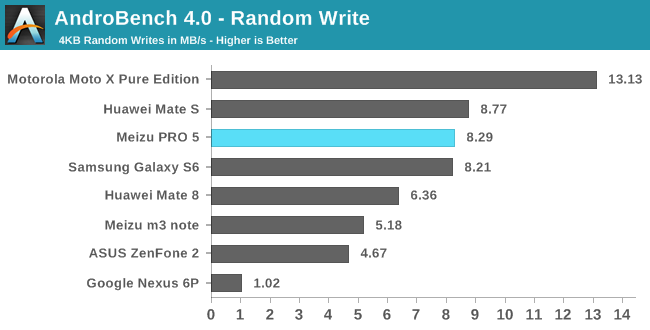
In our internal storage test, the PRO 5 posts very good results across the board, part of the reason why it does so well with launching applications. It’s not surprising that we see the PRO 5 and Galaxy S6 post near identical speeds, because both are using the same UFS 2.0 controller that’s built into the Exynos 7420 SoC and the same KLUBG4G1BD-E0B1 NAND with a maximum queue depth of 16.
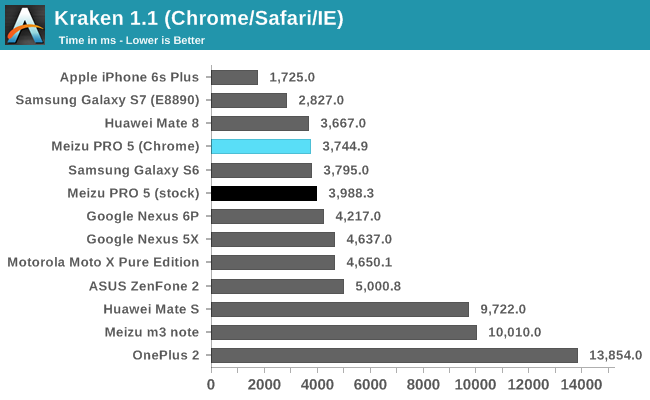
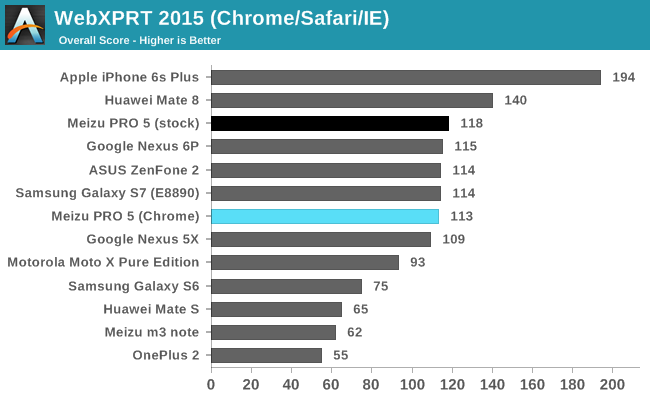

Chrome is the default browser in our web-based JavaScript tests, but we’re also including the results from Meizu’s stock browser for comparison. Unfortunately, it does not provide any better performance than Chrome.
The PRO 5 performs as good or better than the phones with previous generation SoCs. It lands near the top of the chart in Kraken and is around 20% slower than the Mate 8 and its Kirin 950 SoC in JetStream and WebXPRT.
Despite launching at the end of 2015, the PRO 5 still feels plenty fast and compares well to current generation flagship phones. While there is a performance penalty when using the Balance mode to conserve power, it’s generally not severe and not even noticeable in most cases.


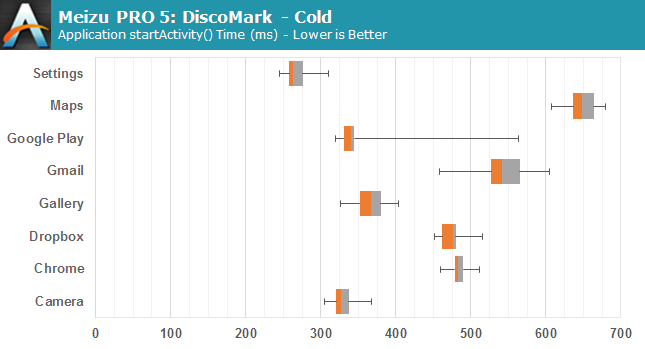









80 Comments
View All Comments
retrospooty - Friday, June 24, 2016 - link
Anandtech will probably review the new 2016 Moto phones ... in 2017 ... Q4 LOL :PSunLord - Friday, June 24, 2016 - link
Anandtech needs to replace it's slow/late writers theirs a difference in taking time to do a good through review on new stuff and being moths late. If you take more then a month to get a review out you shouldn't get important reviews. I expect we'll see a full RX 480 review in time for Vega to ship with the way things have gone down hill and jumped off a cliff when it comes to timely reviews ever since they got sold.kspirit - Friday, June 24, 2016 - link
@retrospooty HA! true.invinciblegod - Friday, June 24, 2016 - link
Wow, racist one here! (Either that or a eurocentrist one, either way)I'm more interested in the phone no one else is reviewing because everyone else already reviewed those other phones. I'd rather see these reviews of different phones.
kspirit - Friday, June 24, 2016 - link
Oh Christ. I am not racist, how dare you accuse someone like that.China is very important for global trade, etc etc. I get all that. But riddle me a single innovation by a Chinese OEM. They take the idea of what other OEMs invent, drop it to bargain basement price (with a quality compromise somewhere along the way), and sell it off. They don't invent jack, they just cram more and more needless hardware in device in a manner of a pissing contest between their own kind. AT is known for in-depth coverage of new and innovative hardware. Chinese OEMs do not fit that bill.
kaidenshi - Friday, June 24, 2016 - link
Not racist either, but I too would like to see more Euro/NA friendly phones reviewed, given this is an English-language site and likely read more by the West than the East.That said, this seems like a really cool phone and I'm glad it was reviewed. If it had North American LTE support I'd buy two.
Impulses - Saturday, June 25, 2016 - link
I dunno whether any Chinese phone OEM has truly innovated, I guess that might largely depend on where you fall on the whole Taiwan thing, but you're casting some pretty big generalisations for which the term isn't wholly unwarranted... Chinese OEM in other markets have definitely come up with novel ideas. /shrug HTC was building phones for a lot of people long before the smartphone went mainstream too...fuicharles - Saturday, June 25, 2016 - link
Chinese OEM Innovation, example:" The use of a curved glass back cover is also awesome and Xiaomi is actually the first OEM to do this to my knowledge. It’s definitely slippery, but the in-hand feel is really much better than the traditional angular glass phones like the Xperia Z line. The fact that Samsung is following here by doing the same for the Note 5 probably says something about just how far Xiaomi has come since their first smartphone."
This is the copy from the Summary by Joshua Ho of Anandtech when review the Xiaomi Mi Note - http://www.anandtech.com/show/9386/the-xiaomi-mi-n...
By the Ways, Huawei Kirin SOC are very successfully recently.
theduckofdeath - Sunday, June 26, 2016 - link
The Galaxy S6 edge had a curved glass back as well, to match the curved front. I guess Joshua jsut didn't think that one though long enough.theduckofdeath - Sunday, June 26, 2016 - link
*The Galaxy S6 edge had a curved glass back as well, to match the curved front. I guess Joshua just didn't think that one through long enough.(Would it be too much asked to get a comment section with a simple edit button like every other site in the world has? :D )